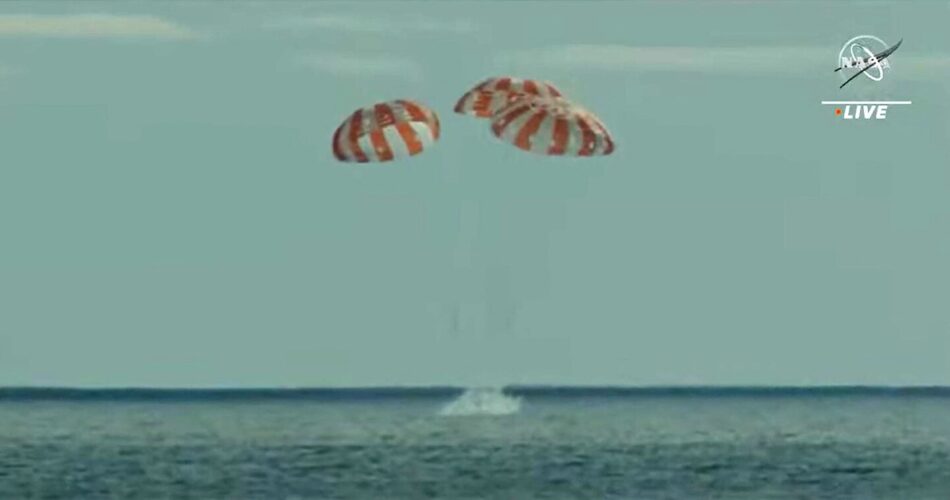Orion’s homecoming came 50 years to the day of the Apollo 17 spacecraft landing on the lunar surface in 1972 at the Taurus-Littrow valley, the last human mission to the moon. And it heralded, the space agency said, a series of upcoming missions that are to be piloted by a new generation of NASA astronauts as part of the space agency’s Artemis program.
The flight was delayed repeatedly by a series of technical problems with the massive Space Launch System rocket and the spacecraft. But the 26-day, 1.4 million-mile mission went “exceedingly well,” NASA officials said, from the launch on Nov. 16 to flybys that brought Orion within about 80 miles of the lunar surface and directly over the Apollo 11 landing site at Tranquility Base.
“From Tranquility Base to Taurus-Littrow to the tranquil waters of the Pacific, the latest chapter of NASA’s journey to the moon comes to a close. Orion, back on Earth,” NASA’s Rob Navias said during the agency’s live broadcast of the event.
NASA Administrator Bill Nelson said it was “historic because we are now going back to space, to deep space, with a new generation.” he said. The successful augurs a new era, he added, “one that marks new technology, a whole new breed of astronauts, and a vision of the future.”
Now that the spacecraft is safely home, NASA will immediately begin to assess the data gathered on the flight and prepare for the Artemis II mission — which would put a crew on astronauts on the spacecraft for another trip in orbit around the moon. NASA hopes that mission would come as early as 2024, with a lunar landing to come as early as 2025, or 2026. The would mark the first time people have walked on the moon since the last of the Apollo missions.
NASA has yet to name the crews assigned to those flights. But its astronaut corps has already shifted its training to focus on Orion and lunar flights, after spending decades focusing solely on missions to the International Space Station.
One of the most significant tests for the Orion spacecraft came Sunday morning when the spacecraft hit Earth’s atmosphere traveling at nearly 25,000 m.p.h., or 32 times the speed of sound. The friction generated extreme temperatures — 5,000 degrees Fahrenheit — that stressed the capsule’s heat shield. A series of parachutes then deployed, delivering the spacecraft to the ocean at under 20 m.p.h., where a Navy recovery ship, the USS Portland, and several other small boats and helicopters were waiting to greet it.
Nelson said that the heatshield performed “beautifully,” and Navias said the landing was “textbook.”
The successful mission gives NASA some momentum after years of stagnation in its human spaceflight program. After it retired the space shuttle fleet in 2011, NASA was forced to rely on Russia to send its astronauts to the space station. SpaceX finally started human spaceflight missions for NASA in 2020, and Boeing, the other company contracted for flights to the ISS, hopes to send its first crew there next year.
But now, for the first time in decades, NASA has another destination for its astronauts — the moon — and a program — Artemis — that was survived subsequent presidential administrations, to get them there.
The program, which vows to land the first woman and person of color on the moon, was born under the Trump administration and carried on by the Biden White House. That continuity stands in stark contrast to decades of presidential administrations pointing NASA’s human space exploration directorate to different goals in the solar system, from the moon, to Mars, an asteroid, and back to the moon again.
The question now is: can NASA keep its momentum and keep Congress funding it? Support for spaceflight programs can be fickle — even the Apollo missions quickly began to lose support and the public’s interest. And while NASA might be celebrating the Artemis I as a triumph today, that enthusiasm could easily fade by the time Artemis II is ready to fly in 2024.
While that remains to be seen, NASA was celebrating the first step toward returning astronauts to the moon and fulfill the pledge of Eugene Cernan, the last man to walk on the moon, who vowed, as he departed the moon for Earth, “We shall return.”
Robert Cabana, NASA’s associate administrator and a former astronaut, said that he wished Cernan “were alive and could have seen this mission. It would have meant a lot to him.”
Source link



